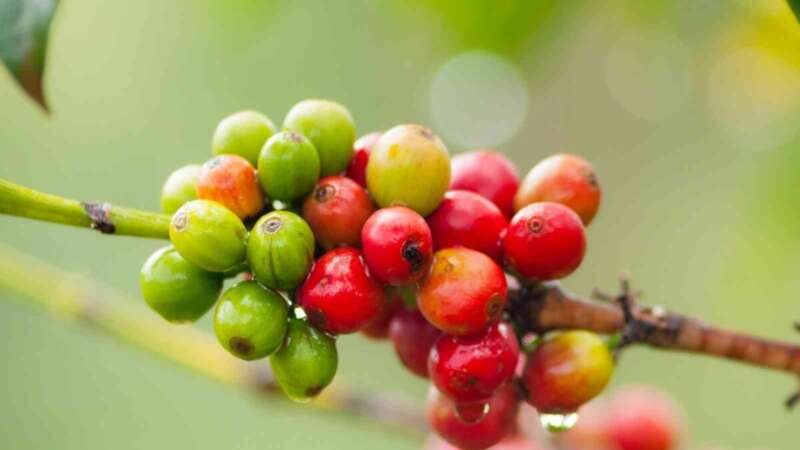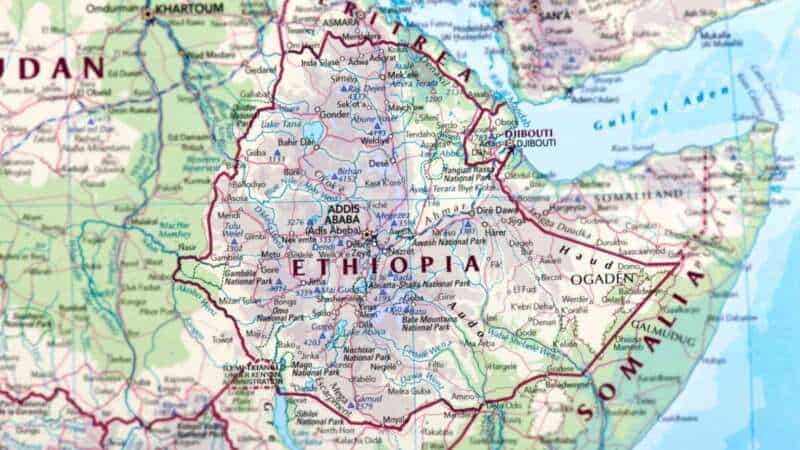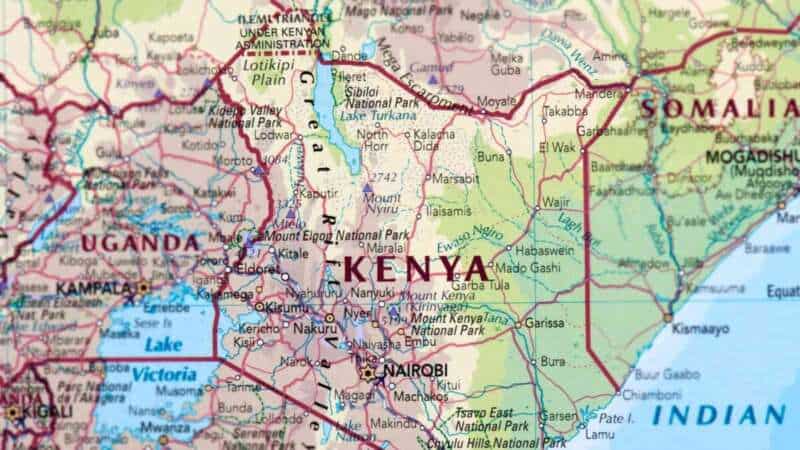Two east African countries that are both famous for their coffees are Ethiopia and Kenya.
The countries share a border of around 530 miles (867 km) and are both coffee producers, but they do have frequent conflict over their border – and it’s usually to do with resources like water.
Ethiopian Coffee vs Kenyan Coffee – an Overview
| Ethiopian Coffee | Kenyan Coffee | |
|---|---|---|
| % Of global market | 5% | 0.5% |
| The main type of coffee | Arabica coffee (native heirloom varieties) | Arabica coffee (SL34, SL28, Batian, Ruiru11) |
| Harvest times | October to December | October to December (with another small harvest from April to June |
| Processes | Natural and washed | Washed (some natural) |
| Annual Coffee Production | 384,000 tonnes (2016) | 54,000 tonnes (2016) |
| Global Ranking | 5th Largest | 16th Largest |
As you can see from the table above, there are some significant differences in terms of coffee production in Ethiopia and Kenya.
Despite having similar climates within East Africa, they are at different stages of their development.
Ethiopian Coffee
Out of all of the world’s coffee origins, Ethiopian coffee is one of the finest. The coffee is not only original and unusual, but its coffee production is also often shrouded in mystery that makes it even more compelling.
In actual fact, coffee is believed to have originated in Ethiopia. Legend states that a goat herder named Kaldi discovered the first coffee plants after his goats ate their berries.
Apparently, he decided to investigate further owing to the fact that his goats had boundless energy and wouldn’t sleep.

After this experience, this goat herder reported what he’d discovered to an abbot at his local monastery. The abbot then went on to make a drink from these berries and discovered he was alert for the evening prayers, so the story goes.
As word got out, coffee spread far and wide through the Arabian Peninsula where it began a long journey to reach all corners of the globe.
Nowadays, Ethiopia is Africa’s largest producer of coffee and is the home to the world’s most popular coffee beans – Arabica.
As a result, coffee makes up almost one-third of Ethiopia’s exports each year and there are around fifteen million people involved in the coffee industry from picking the coffee beans to its exportation.
Kenyan Coffee
Kenyan coffee beans are also of the Arabica variety and have been recognized globally as having an exquisite, unique taste.
The country has a favorable climate for producing coffee and Kenyan coffee is enjoyed in abundance through the USA and Europe. Kenyan coffees have a fruity, sharp acidity, a rich fragrance, and a full body.

There is a unique grading system for coffee in Kenya. AA+ means the bean is estate-grown and AA is the largest size of coffee bean out of 10 different sizes.
In Kenya, coffee grows in Mount Kenya’s foothills and is grown most often by smaller coffee farmers. The producers in Kenya place a huge emphasis on high quality so the processes for drying coffee beans are monitored and controlled very carefully.
The Processes of Making Coffee
When processing coffee, there are two distinct methods:
- Sun-dried Natural Method
- Fully Washed Method
Unlike Colombia which uses the fully washed method entirely, Ethiopia uses both.
When we’re talking about the coffee processing method, we’re simply referring to how the coffee bean is removed.
For the sun-dried process, the berries are put out to dry naturally in the sun. When they’re dry, it’s easy to remove the hulks. Sun-drying is the most natural way of processing coffee beans.
For the washed process, the skin is removed when the cherry is harvested and then any pulp remaining is washed away. Once the beans are exposed b washing, they’re put in the sun to dry out.
This is not as natural a process, but it is quicker.
Coffee Growing and Processing in Ethiopia
There are lots of different growing regions in Ethiopia with the main ones being Sidama and Harrar. Coffees from these regions have distinct and unique flavors.
Harrar
This region is in the east of Ethiopia and is split into four smaller areas. In Harrar, the coffee is sun-dried and has a fruity taste. Lots of the coffee beans here are golden or amber in color, and there are lots of coffees with a blueberry flavor.

Sidama
Sidama is located in the south of Ethiopia and there it uses both types of coffee processing methods. This is where you’ll find lots of different flavors due to the variety of microclimates in this region. You’ll get fruity coffees here, but they’re often more complex flavors.
Other Coffee-Growing Regions
As well as the two regions mentioned above, there are three forest areas called Bonga, Jimma, and Limu that produce coffee with a well-balanced flavor.
Coffee Growing and Processing in Kenya
In Kenya, you’ll find Arabic coffee plants growing on the rich volcanic highland soil from 1400 meters up to 2000 meters above sea level with temperatures ranging from 15° to 24° Celsius.
Since the beans are grown at high altitudes, they qualify for SHG (Strictly High Grown) and SHB (Strictly High Bean) status.
Due to the altitude at which the coffee beans are grown, their growth is slower and so they contain more nutrients.
The higher altitudes of the growing affect how the coffee tastes and they’re often more acidic than other coffee types, like Ethiopian beans.
Kenyan coffee is very aromatic as well as acidic and has a taste profile that is fruity and wine-like. There are typically two tastes when it comes to Kenyan coffees – tropical, crisp flavors or big, bold flavors.
Kenya has somewhere in the region of 330 farms that are bigger than 15 hectares in size, which means that more than 50% of its coffee growers are smallholders that only have two or three hectares of land.

Coffee is most often grown in these Kenyan regions:
- Regions of Mount Kenya – Kirinyaga, Thika, Nyeri, Kiambu, and Murang’a
- Nandi Hills and the wider Rift Valley
- Western Kenya – Mount Elgon and Bungoma
- Eastern Kenya – Meru, Machakos, and Embu
Around 90% of Kenyan coffee is wet-processed. You’ll actually find that the Kenyan people aren’t very big coffee drinkers themselves and often prefer tea.
Despite Kenya having great locations to grow coffee plants, they developed their coffee growing areas late compared to Ethiopia.
What Are the Main Differences Between Ethiopian and Kenyan Coffees?
In contrast with Kenyan coffee, the coffee from Ethiopia tends to have a mild acidity and a more subtle body.
Ethiopian coffees are also more tea-like and floral. You can often sense blueberry, bergamot, and jasmine notes.
Kenyan coffee, on the other hand, is brighter and more acidic, as previously mentioned.
Final Thoughts
While there are big differences in growing and coffee production, both Ethiopian and Kenyan Coffee have delicious flavors and are rated among the best in the world.
Both countries have excellent artisan coffee producers, meaning that they both produce well-liked coffee.
It’s hard to choose between Ethiopia’s native heirloom variety and Kenya’s high-altitude growing as they both have wonderful flavors and aromas.
The truth is, if you like Ethiopian coffee, you’ll probably like Kenyan coffee too!